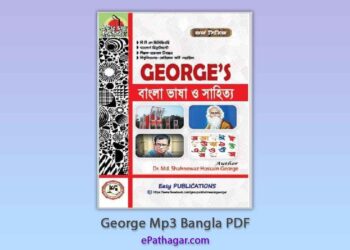For Whom the Bell Tolls by Ernest Hemingway is a poignant exploration of love, sacrifice, and the brutality of war. Set against the backdrop of the Spanish Civil War, the novel follows Robert Jordan, an American dynamite who joins a guerrilla band tasked with blowing up a bridge behind enemy lines. Hemingway masterfully weaves together themes of camaraderie, duty, and existentialism as Jordan grapples with his own mortality and the futility of violence. Through vivid prose and stark realism, Hemingway captures the harsh realities of war and the complex emotions of those caught in its grip. Against the looming specter of death, Jordan finds solace and purpose in his love affair with Maria, a young Spanish woman, adding a tender yet tragic layer to the narrative. For Whom the Bell Tolls Book Summary stands as a timeless testament to the human spirit’s resilience amidst the chaos of conflict.
For Whom the Bell Tolls Book Summary
Ernest Hemingway’s For Whom the Bell Tolls is a novel that transcends its time, weaving a tapestry of themes that resonate deeply with readers across generations. Set during the Spanish Civil War, the novel follows the journey of Robert Jordan, an American dynamite who joins a guerrilla band fighting against the fascist forces. Through Jordan’s eyes, Hemingway paints a vivid portrait of the chaos and brutality of war while also delving into the complexities of human relationships, the struggle for meaning in the face of mortality, and the timeless question of whether one’s actions have lasting significance.
At its core, For Whom the Bell Tolls is a meditation on the nature of war and its impact on those who are caught in its grasp. Hemingway’s portrayal of the Spanish Civil War is unflinchingly realistic, capturing the horrors of combat with stark clarity. From the opening pages, the reader is thrust into the midst of battle, where death and destruction are constant companions. Hemingway’s spare prose style, devoid of sentimentality or embellishment, serves to heighten the sense of immediacy and intensity, drawing the reader into the heart of the conflict.
One of the novel’s most powerful themes is the idea of sacrifice and the willingness of individuals to give their lives for a cause greater than themselves. Throughout the story, Jordan and his fellow guerrillas grapple with questions of duty and morality as they carry out their mission to destroy a strategic bridge behind enemy lines. For Jordan, the mission becomes not just a military objective but a personal quest for redemption and purpose. As he navigates the moral complexities of warfare, he is forced to confront his own beliefs about justice, honor, and the value of human life.
Central to Jordan’s journey is his relationship with Maria, a young Spanish woman who has endured unspeakable horrors at the hands of the enemy. Their love affair serves as a poignant counterpoint to the violence and chaos of war, offering moments of tenderness and intimacy amidst the devastation. Through Maria, Hemingway explores the resilience of the human spirit in the face of adversity, as well as the capacity for love to transcend even the darkest of circumstances. Yet their romance is also tinged with tragedy, as Jordan grapples with the knowledge that their time together may be fleeting and that their love may ultimately be overshadowed by the specter of death.
In addition to its exploration of war and love, For Whom the Bell Tolls Book Summary also delves into deeper philosophical questions about the nature of existence and the meaning of life. As Jordan reflects on his own mortality and the fleeting nature of human existence, he is forced to confront the fundamental absurdity of the human condition. Yet even in the face of despair, he finds moments of transcendence and beauty, whether in the simple pleasures of nature or the bonds of friendship forged in the crucible of war.
Throughout the novel, Hemingway employs a variety of literary techniques to convey the emotional and thematic depth of the story. His use of symbolism, imagery, and metaphor adds layers of meaning to the narrative, inviting readers to engage with the text on multiple levels. The title itself, taken from John Donne’s famous poem, serves as a powerful metaphor for the interconnectedness of all humanity as well as the inevitability of death. Similarly, Hemingway’s descriptions of the natural world—the rugged mountains, the flowing rivers, and the starry skies—serve as a reminder of the beauty and fragility of life, even in the midst of destruction.
For Whom the Bell Tolls is also notable for its complex and nuanced characterization. In addition to Jordan and Maria, Hemingway introduces a rich cast of supporting characters, each with their own hopes, fears, and motivations. From the grizzled guerrilla leader Pablo to the enigmatic Anselmo to the idealistic young Pilar, each character contributes to the novel’s exploration of themes such as loyalty, betrayal, and the search for meaning in a chaotic world. Hemingway’s ability to inhabit the minds of his characters and to depict their inner struggles and contradictions with empathy and insight is one of the novel’s greatest strengths.

What are the weaknesses of this book?
For Whom the Bell Tolls Book Summary is widely regarded as a literary classic, but it is not without its weaknesses. One criticism often leveled at the novel is its pacing, which can be slow and meandering at times. Hemingway’s sparse prose style, while effective in conveying the immediacy and intensity of war, can also make the narrative feel disjointed and fragmented. Some readers may find themselves struggling to stay engaged with the story, particularly during the lengthy passages of internal monologue and philosophical reflection.
Another weakness of the book lies in its portrayal of female characters. While Maria, the love interest of the protagonist, Robert Jordan, is given significant attention and depth, other female characters in the novel are often relegated to secondary roles or depicted in a stereotypical manner. Hemingway’s treatment of women, while reflective of the attitudes of his time, can feel dated and reductive to modern readers, detracting from the overall impact of the story. Some critics have taken issue with Hemingway’s portrayal of the Spanish Civil War, arguing that it oversimplifies the complex political and social dynamics of the conflict. While the novel offers a visceral depiction of the horrors of war, it can be criticized for romanticizing the guerrilla struggle and portraying the Republican cause in overly idealistic terms.
Despite these weaknesses, For Whom the Bell Tolls Summary remains a powerful and thought-provoking work of literature that continues to resonate with readers around the world. While it may not be without its flaws, its enduring themes and insights into the human condition ensure that it remains a fixture of the literary canon for generations to come.
Also Read: Spoken English Book PDF Free Download
For Whom the Bell Tolls Book Age Rating: Suitable Ages Of Readers
For Whom the Bell Tolls Book Summary by Ernest Hemingway is a novel that contains mature themes and scenes of violence, making it more suitable for older readers. Due to its depiction of war, including graphic descriptions of combat and its aftermath, as well as themes of death, love, and existentialism, it is generally recommended for readers aged 16 and above. Younger readers may find some of the content disturbing or difficult to understand without proper context and guidance. Parents and educators should consider the individual maturity level of each reader when determining whether the book is appropriate for them. Discussions about the historical context of the Spanish Civil War and Hemingway’s writing style may enhance the reading experience for younger readers who are interested in tackling more challenging literary works.
Was there any way to improve the book For Whom the Bell Tolls?
For Whom the Bell Tolls Summary could involve enhancing the pacing to maintain reader engagement throughout the narrative. While Hemingway’s spare prose style is characteristic of his work, providing vivid descriptions of the setting and characters could further immerse readers in the story. a more nuanced portrayal of female characters beyond the protagonist’s love interest could add depth and complexity to the novel. Exploring their perspectives and agency within the context of the Spanish Civil War could enrich the overall narrative. Moreover, incorporating a more balanced and nuanced depiction of the political and social dynamics of the conflict may offer readers a deeper understanding of the historical context. By addressing these aspects, the novel could resonate more profoundly with contemporary audiences while retaining its timeless themes and insights into the human condition.
Do readers of 2024 demand this book?
As of 2024, readers continue to seek out classics like For Whom the Bell Tolls Book Summary for their enduring themes, timeless insights, and historical significance. While contemporary readers may have diverse interests and preferences, there remains a demand for literature that delves into complex human experiences and explores the moral, emotional, and existential dilemmas faced by individuals in times of conflict. Hemingway’s portrayal of war, love, and the search for meaning resonates with readers seeking thought-provoking narratives that transcend the boundaries of time and place. The novel’s exploration of themes such as sacrifice, loyalty, and the human condition offers readers opportunities for introspection and reflection, making it relevant to audiences seeking deeper engagement with literature. as society continues to grapple with issues of violence, injustice, and the consequences of war, the themes and questions raised in For Whom the Bell Tolls Summary remain as pertinent today as they were when the novel was first published. Thus, while readers’ tastes and preferences may evolve over time, the enduring appeal of Hemingway’s masterpiece ensures that it continues to captivate and resonate with audiences in 2024 and beyond.
Purchase This Book From Amazon
Should this book be worth reading now, in 2024?
Yes, the For Whom the Bell Tolls Summary remains worth reading in 2024. Despite being written in a different era, the novel’s exploration of timeless themes such as love, sacrifice, and the human condition transcends its historical context. Hemingway’s powerful prose and vivid portrayal of the Spanish Civil War offer readers a compelling narrative that resonates with contemporary issues and concerns. The characters’ struggles with morality, duty, and the search for meaning continue to speak to readers across generations, inviting reflection on the complexities of life and the impact of war on individuals and society. The novel’s relevance is enhanced by its exploration of themes such as gender dynamics, political ideology, and the consequences of violence, which remain relevant in today’s world. By engaging with For Whom the Bell Tolls Book Summary, readers have the opportunity to deepen their understanding of history, humanity, and the enduring power of literature to illuminate the human experience. Thus, in 2024 and beyond, Hemingway’s masterpiece continues to captivate and inspire readers with its timeless wisdom and profound insights.
Conclusion: For Whom the Bell Tolls Book Summary
Ernest Hemingway’s For Whom the Bell Tolls stands as a timeless masterpiece that explores the complexities of love, sacrifice, and the brutality of war. Set against the backdrop of the Spanish Civil War, the novel follows the journey of Robert Jordan, an American dynamite tasked with destroying a strategic bridge behind enemy lines. Through Hemingway’s spare prose and vivid imagery, readers are transported into the heart of the conflict, where death and destruction are constant companions. Yet amidst the chaos of war, Jordan finds solace and purpose in his love affair with Maria, a young Spanish woman who has endured unimaginable horrors. Their relationship serves as a poignant counterpoint to the violence and despair, offering moments of tenderness and intimacy amidst the devastation. As Jordan grapples with questions of duty, morality, and the fleeting nature of existence, he is forced to confront the fundamental absurdity of the human condition. For Whom the Bell Tolls Summary is a profound meditation on the enduring power of love, the resilience of the human spirit, and the search for meaning in a world torn apart by violence and injustice. Through its richly drawn characters, evocative prose, and timeless themes, the novel continues to resonate with readers, inviting reflection on the complexities of the human experience and the enduring quest for hope and redemption.













This Post Has One Comment
[…] Also Read: For Whom the Bell Tolls Book Summary – Sparknotes PDF […]